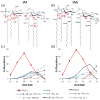Characterization of Lipid A Variants by Energy-Resolved Mass Spectrometry: Impact of Acyl Chains
- PMID: 27966172
- PMCID: PMC5438766
- DOI: 10.1007/s13361-016-1542-6
Characterization of Lipid A Variants by Energy-Resolved Mass Spectrometry: Impact of Acyl Chains
Abstract
Lipid A molecules consist of a diglucosamine sugar core with a number of appended acyl chains that vary in their length and connectivity. Because of the challenging nature of characterizing these molecules and differentiating between isomeric species, an energy-resolved MS/MS strategy was undertaken to track the fragmentation trends and map genealogies of product ions originating from consecutive cleavages of acyl chains. Generalizations were developed based on the number and locations of the primary and secondary acyl chains as well as variations in preferential cleavages arising from the location of the phosphate groups. Secondary acyl chain cleavage occurs most readily for lipid A species at the 3' position, followed by primary acyl chain fragmentation at both the 3' and 3 positions. In the instances of bisphosphorylated lipid A variants, phosphate loss occurs readily in conjunction with the most favorable primary and secondary acyl chain cleavages. Graphical Abstract ᅟ.
Keywords: Acyl chain; Collisional activation; Lipid A; Tandem mass spectrometry.
Figures






Similar articles
-
Characterization of complex, heterogeneous lipid A samples using HPLC-MS/MS technique III. Positive-ion mode tandem mass spectrometry to reveal phosphorylation and acylation patterns of lipid A.J Mass Spectrom. 2018 Feb;53(2):146-161. doi: 10.1002/jms.4046. J Mass Spectrom. 2018. PMID: 29144587
-
Characterization of complex, heterogeneous lipid A samples using HPLC-MS/MS technique II. Structural elucidation of non-phosphorylated lipid A by negative-ion mode tandem mass spectrometry.J Mass Spectrom. 2016 Aug;51(8):615-628. doi: 10.1002/jms.3786. J Mass Spectrom. 2016. PMID: 28239963
-
Identification of a Chimera Mass Spectrum of Isomeric Lipid A Species Using Negative Ion Tandem Mass Spectrometry.Toxins (Basel). 2024 Jul 18;16(7):322. doi: 10.3390/toxins16070322. Toxins (Basel). 2024. PMID: 39057962 Free PMC article.
-
Analysis of mammalian fatty acyl-coenzyme A species by mass spectrometry and tandem mass spectrometry.Biochim Biophys Acta. 2011 Nov;1811(11):663-8. doi: 10.1016/j.bbalip.2011.05.010. Epub 2011 Jun 6. Biochim Biophys Acta. 2011. PMID: 21679775 Review.
-
Collisional activation of peptide ions in FT-ICR mass spectrometry.Mass Spectrom Rev. 2003 May-Jun;22(3):158-81. doi: 10.1002/mas.10041. Mass Spectrom Rev. 2003. PMID: 12838543 Review.
Cited by
-
Mass spectrometric analysis of lipid A obtained from the lipopolysaccharide of Pasteurella multocida.RSC Adv. 2020 Aug 20;10(51):30917-30933. doi: 10.1039/d0ra05463a. eCollection 2020 Aug 17. RSC Adv. 2020. PMID: 35516050 Free PMC article.
-
Lipid A Remodeling Is a Pathoadaptive Mechanism That Impacts Lipopolysaccharide Recognition and Intracellular Survival of Burkholderia pseudomallei.Infect Immun. 2018 Sep 21;86(10):e00360-18. doi: 10.1128/IAI.00360-18. Print 2018 Oct. Infect Immun. 2018. PMID: 30037795 Free PMC article.
-
LipidA-IDER to Explore the Global Lipid A Repertoire of Drug-Resistant Gram-Negative Bacteria.Anal Chem. 2023 Jan 17;95(2):602-611. doi: 10.1021/acs.analchem.1c03566. Epub 2023 Jan 4. Anal Chem. 2023. PMID: 36599414 Free PMC article.
-
Ultraviolet Photodissociation Mass Spectrometry for Analysis of Biological Molecules.Chem Rev. 2020 Apr 8;120(7):3328-3380. doi: 10.1021/acs.chemrev.9b00440. Epub 2019 Dec 18. Chem Rev. 2020. PMID: 31851501 Free PMC article. Review.
-
Uncovering the fragmentation and separation characteristics of sophorolipid biosurfactants with LC-MS-ESI.J Ind Microbiol Biotechnol. 2024 Jan 9;51:kuae035. doi: 10.1093/jimb/kuae035. J Ind Microbiol Biotechnol. 2024. PMID: 39327028 Free PMC article.
References
-
- Kaye KS, Pogue JM. Infections Caused by Resistant Gram-Negative Bacteria: Epidemiology and Management. Pharmacother J Hum Pharmacol Drug Ther. 2015;35:949–962. - PubMed
-
- Bouchillon SK, Badal RE, Hoban DJ, Hawser SP. Antimicrobial Susceptibility of Inpatient Urinary Tract Isolates of Gram-Negative Bacilli in the United States: Results from the Study for Monitoring Antimicrobial Resistance Trends (SMART) Program: 2009–2011. Clin Ther. 2013;35:872–877. - PubMed
-
- Bush K. Investigational Agents for the Treatment of Gram-Negative Bacterial Infections: A Reality Check. ACS Infect Dis. 2015;1:509–511. - PubMed
-
- Whitfield C, Trent MS. Biosynthesis and export of bacterial lipopolysaccharides. Annu Rev Biochem. 2014;83:99–128. - PubMed
MeSH terms
Substances
Grants and funding
LinkOut - more resources
Full Text Sources
Other Literature Sources
Molecular Biology Databases

